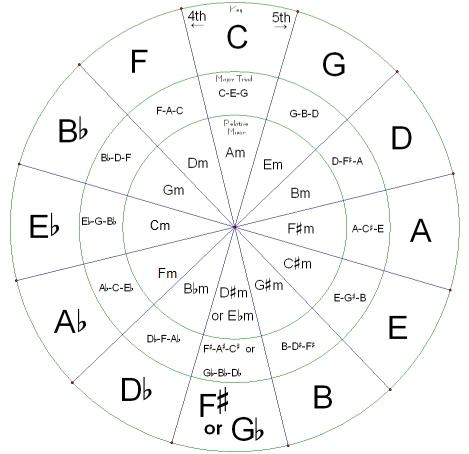In 2004, GospelKeys 202 got a lot of buzz because I introduced a concept I call “coupling.”
The premise was basically to look at chord progressions as small “couples.”
A couple or pair is 2!
When you think in terms of “couples,” you to focus on two things:
1) What chord does this current one strongly pull to?
2) What chord pulls strongly to this current one?
And truth be told, it’s all centered around the “circle of fifths.”

Back in 2004, I called it the “3-4” principle.
Basically, you just take the tone of the scale you’re on and either go up 3 scale tones or down 4 scale tones.
So if you’re in C major, and you’re trying to find out what chord is most likely to come after a “D minor” chord, you just start at “D” and go up 3 scale tones:
D — E — F — G
So E is the 1st scale tone up, then F, then your destination, G.
You can also go down 4 scale tones (thus the name “3-4” principle).
D — C — B — A — G
You’ll end up at the same place.
—-
Take a look at the circle. Notice that “D” and “G” are neighbors. So using the “3-4” principle inside of a major key and referring to the circle will give you the same result.
Note: When referring to the circle, you’re focusing on the counter-clockwise direction of the keys. So rather than going from C to G to D, you’re going from C to F to Bb and so forth. Imagine your clock working backwards!
Now here’s the thing…
If you focus on mastering “couples,” you can kill two birds with one stone.
Not only are you learning how music works but you’re learning how to play in all 12 keys without even knowing it!
Because D to G has major functions in more than 7 keys, if you really think about it. So by learning all the different possibilities between D and G, you’re actually prepping yourself to use this combination whenever you need it.
I guess learning entire keys at once (which I advocate as well) is the “macro” technique and focusing on very small couples and all the possibilities between them is the “micro” way of doing it.
But imagine if you just took one day to focus on as many chords and situations that involve D going to G?
In the key of C major, you’d find that “D” to “G” operates as a “2-5” progression (because D is the second tone of the scale and G is the fifth tone of the scale).
In the key of D major, “D” to “G” operates as a “1-4” progression.
In the key of Eb major, “D” to “G” operates as a “7-3” progression (or couple).In the key of F, “D” to “G” operates as a “6-2” couple.
In the key of G, “D” to “G” is a “5-1” progression.
In the key of Ab, although “D” isn’t in the major scale, it has a very common function. “D” to “G” operates as “b5-7” progression. You’ll find this in many songs.
And in the key of Bb, “D” to “G” operates as a “3-6” progression.
When you combine these various couples, you get bigger progressions like the “6-2-5-1 turnaround.” (But at the end of the day, these can be broken down to smaller parts and focused on until you’ve committed them to memory).
Another important thing to note is that you’ll play the same exact chords on “D” and “G” across different keys. So the “6-2” couple that occurs in the key of F will use the same EXACT chords as the “3-6” progression in Bb major. No difference at all. So if you play well in F major but “suck” in Bb major, it’s because you haven’t made “the connection” yet. Many of those same chord progressions or “couples” will repeat in other keys. It’s just that we don’t realize it because we’re blinded by a “new key” to learn.
Since this is what you call an “introductory” lesson to a rather new concept on the blog (or should I say “reintroduced” concept), it may not gel right away. But I’ll continue this series of posts.
For now, start taking the circle of fifths and start pairing two neighbors at a time finding out their roles in as many keys as you can.
Soon you’ll know all the neighbors and you’ll feel comfortable hanging out with all of em! :-)
Until next time—







Comments on this entry are closed.